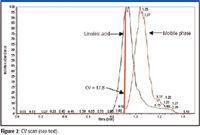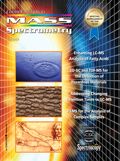FAIMS Removes Chemical Background and Interference from the Analysis of Linoleic Acid in Cancer Cell Extracts
Special Issues
Assay sensitivity is the lowest concentration at which a targeted analyte can be measured and is often limited by chemical background or co-eluting interferences. FAIMS in combination with liquid chromatography (LC) and zero neutral loss tandem MS was used to remove chemical background and co-eluting interferences from the analysis of linoleic acid in cancer cell extracts. Concentration of endogenous linoleic acid was determined from back-calculation of standard calibration samples fortified with deuterium-labeled linoleic acid. No internal standard was used. LC–MS-MS analysis of the cancer cell extracts resulted in an increase in signal-to-noise ratio of 10-fold. The assay sensitivity was increased 10 times over the traditional LC–MS-MS experiment exclusively due to the new FAIMS technology.
Assay sensitivity is the lowest concentration at which a targeted analyte can be measured and is often limited by chemical background or co-eluting interferences. FAIMS in combination with liquid chromatography (LC) and zero neutral loss tandem MS was used to remove chemical background and co-eluting interferences from the analysis of linoleic acid in cancer cell extracts. Concentration of endogenous linoleic acid was determined from back-calculation of standard calibration samples fortified with deuterium-labeled linoleic acid. No internal standard was used. LC–MS-MS analysis of the cancer cell extracts resulted in an increase in signal-to-noise ratio of 10-fold. The assay sensitivity was increased 10 times over the traditional LC–MS-MS experiment exclusively due to the new FAIMS technology.
Linoleic acid is used in lipid metabolism studies because elevated levels of this essential fatty acid are associated with increased cancer risk. Fatty acids such as linoleic acid are normally analyzed by gas chromatography–mass spectrometry (GC–MS) because they provide the necessary sensitivity, but they also involve time and labor-intensive derivatization. Fatty acid analysis by liquid chromatography (LC)–MS is simpler than GC–MS because no derivatization is required. Sometimes, the resulting LC–MS chromatograms show high chemical background or coeluted interferences, which may affect the detection limit.
High-field asymmetric waveform ion mobility spectrometry (FAIMS) is a new technique, similar to gas-phased electrophoresis, that increases the selectivity of LC–MS methods. This article discusses a method in which zero neutral loss tandem MS (also known as survivor ion scanning or even single ion monitoring [SIM]-SIM) is used together with LC and FAIMS to reduce the chemical background and remove isobaric chromatographic interferences.
Methods
All standard calibration samples were diluted in methanol to final concentrations between 0.1 and 1000 ng/mL. Cancer cell sample extracts were injected after standard isolation techniques. Instrument tuning was accomplished with a 1 μg/mL solution of linoleic acid in methanol.
A Thermo Scientific Surveyor autosampler and MS pump were used. The column was a 50 mm × 2.1 mm, 3-μm dp Thermo Scientific Hypersil GOLD column. Mobile phase A was 10 mM ammonium acetate and 0.05% formic acid in water, and mobile phase B was methanol. The flow rate was 600 μL/min and the injection volume was 10 μL. The gradient was held at 50% B for 30 s before ramping to 90% B at 1 min. A slow gradient was then used, ramping to 100% B over the next 2 min. Injections were made every 4.5 min.
The MS system used in this study was a Thermo Scientific TSQ Quantum Ultra in negative H-ESI mode with FAIMS system. All MS settings were determined automatically by Quantum Tune software. Linoleic acid and the deuterium-labeled internal standard did not form useful fragment ions in negative ion tandem MS. Therefore, zero neutral loss tandem MS was used; both Q1 and Q3 are set to the same m/z value of the molecular ion. In this case, linoleic acid used the transition m/z 279 > m/z 279 and the internal standard, linoleic acid-d4, used the transition m/z 283 > m/z 283. The scan time was 100 ms for each transition at unit resolution.
The standard FAIMS conditions used were dispersion voltage (DV) 5000 V, outer bias voltage (OBV) -35 V, inner and outer electrode temperatures 70 °C and 90 °C, respectively, and 50% He in N2 at 3 L/min. The FAIMS selectivity parameter, compensation voltage (CV), was determined at 17.8V for both the unlabeled linoleic acid and the deuterium-labeled linoleic acid-d4.

Figure 1
Results and Discussion
Because of the high endogenous concentrations of linoleic acid, standard calibration samples used deuterium-labeled linoleic acid-d4. The resulting calibration line was used to measure concentrations of unlabeled linoleic acid in the cancer cell extracts. The analysis of linoleic acid standard calibration samples showed that the mobile phase contributed significant chemical background to the analysis, as shown in Figure 1a. This chemical background limited the lower level of quantitation (LLOQ). In addition, sample analysis of cancer cell extracts showed interferences (Figure 1b). To remove these problems with the analytical method, FAIMS was explored.

Figure 2
For FAIMS analysis, the selectivity parameter is the CV. The basic experiment for targeted LC–FAIMS-MS is to infuse a reference solution and scan the CV from 0 to 30 V. In this case, a maximum signal was determined at 17.8 V as shown in Figure 2. To ensure that the mobile phase would be excluded, the mobile phase was infused to the system and the CV was scanned again. The result is overlaid with the signal from linoleic acid in Figure 2. Because the mobile phase is separated with FAIMS from the linoleic acid, when a CV of 17.8 V is used, most of the mobile phase signal will be excluded from the MS, significantly reducing the chemical background, and the chromatogram should appear cleaner.

Figure 3
The analysis of standard calibration samples in Figure 3 demonstrates that the chromatograms have significantly less chemical background and that the signal-to-noise ratio (S/N) has improved dramatically. Table I shows the quantitative results from the analysis of three replicates of standard calibration samples. The accuracy and precision are well within the generally accepted values of less than 15% for each. In addition, the LLOQ has improved 10-fold.

Table I: Quantitative results from the analysis of three replicates of standard calibration samples
The final and most important test for any new method comes during sample analysis. Cancer cell extracts analyzed by LC–MS show appreciable chemical background and interferences. However, with the LC–FAIMS-MS method, these same samples show significantly fewer interferences and chemical background (Figure 4). The chromatograms show fewer interferences and the S/N has improved 10-fold.

Figure 4
Conclusion
FAIMS removed chemical background and isobaric interferences from the analysis of linoleic acid in cancer cell extracts. The S/N was increased 10-fold, which translated into a 10X lowering of the lower level of quantification. Compared with traditional LC–MS, the assay was more robust with FAIMS. One important consequence of this work is that because the LLOQ was reduced by a factor of ten, it opens up access for analysis of matrix-limited samples such as for newborns.
Uddhav Kelavkar and Justin Hutzley are with the University of Pittsburgh, Pittsburgh, Pennsylvania. Jonathan McNally is with Thermo Fisher Scientific, San Jose, California. James Kapron is with Thermo Fisher Scientific, Ottawa, Canada.

High-Speed Laser MS for Precise, Prep-Free Environmental Particle Tracking
April 21st 2025Scientists at Oak Ridge National Laboratory have demonstrated that a fast, laser-based mass spectrometry method—LA-ICP-TOF-MS—can accurately detect and identify airborne environmental particles, including toxic metal particles like ruthenium, without the need for complex sample preparation. The work offers a breakthrough in rapid, high-resolution analysis of environmental pollutants.
Trending on Spectroscopy: The Top Content of 2024
December 30th 2024In 2024, we launched multiple content series, covered major conferences, presented two awards, and continued our monthly Analytically Speaking episodes. Below, you'll find a selection of the most popular content from Spectroscopy over the past year.